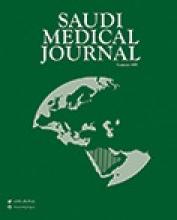Abstract
OBJECTIVE: To evaluate the prostate cancer detection rate in 45 patients who underwent transrectal ultrasound scan (TRUS) guided biopsies at King Abdul-Aziz University Hospital (KAUH), Jeddah, Kingdom of Saudi Arabia (KSA) and compare it with the previously reported national and international rates.
METHODS: Forty-five charts reviewed for patients underwent TRUS guided biopsies in the period between July 1997 through to November 2002 at KAUH. Patients were entered in the study either as of high serum prostatic specific antigen (PSA) or abnormal digital rectal examination (DRE), or both. Cases with large prostate size or suspected elevation of PSA due to causes other than prostatic cancer was excluded from the study.
RESULTS: Out of the 45 patients who underwent TRUS guided biopsy; cancer of the prostate was detected in 13 (28.8%). The cancer detection rate in patients presented with abnormal DRE alone was 7.6%, and was 15.3% in the group with elevated PSA but normal DRE (stage T1c). When PSA was elevated to 4-10ng/ml TRUS guided biopsy detected cancer in 21.4%, elevation of PSA to10-20ng/ml lead to cancer detection in 40% of the patients, and when PSA was above 20ng/ml all cases were positive for cancer.
CONCLUSION: Cancer prostate is common in Western countries; national studies reported a low incidence of prostate cancer in KSA. Yet in our local patients using this precise method of investigation, our study confirms that the detection rate of prostate cancer through TRUS guided biopsies match the results of previously reported national studies and still lower than the international rates. Although the number of cases are small to draw solid and final conclusions; this study should stimulate further research and more reports on this important subject.
- Copyright: © Saudi Medical Journal
This is an open-access article distributed under the terms of the Creative Commons Attribution-Noncommercial-Share Alike 3.0 Unported, which permits unrestricted use, distribution, and reproduction in any medium, provided the original work is properly cited.






